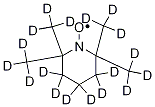Tempo-d18
Modify Date: 2024-01-14 10:44:08

Tempo-d18 structure
|
Common Name | Tempo-d18 | ||
|---|---|---|---|---|
| CAS Number | 205679-68-1 | Molecular Weight | 174.356232004 | |
| Density | N/A | Boiling Point | N/A | |
| Molecular Formula | C9D18NO* | Melting Point | N/A | |
| MSDS | N/A | Flash Point | N/A | |
Use of Tempo-d18Tempo-d18 is the deuterium labeled Tempo[1]. Tempo is a classic nitroxide radical and is a selective scavenger of ROS that dismutases superoxide in the catalytic cycle. Tempo induces DNA-strand breakage. Tempo can be used as an organocatalyst for the oxidation of primary alcohols to aldehydes. Tempo has mutagenic and antioxidant effects[2][3][4][5]. |
| Name | 2,2,6,6-Tetramethylpiperidine-d18-1-oxyl |
|---|
| Description | Tempo-d18 is the deuterium labeled Tempo[1]. Tempo is a classic nitroxide radical and is a selective scavenger of ROS that dismutases superoxide in the catalytic cycle. Tempo induces DNA-strand breakage. Tempo can be used as an organocatalyst for the oxidation of primary alcohols to aldehydes. Tempo has mutagenic and antioxidant effects[2][3][4][5]. |
|---|---|
| Related Catalog | |
| In Vitro | Stable heavy isotopes of hydrogen, carbon, and other elements have been incorporated into drug molecules, largely as tracers for quantitation during the drug development process. Deuteration has gained attention because of its potential to affect the pharmacokinetic and metabolic profiles of drugs[1]. |
| References |
| Molecular Formula | C9D18NO* |
|---|---|
| Molecular Weight | 174.356232004 |